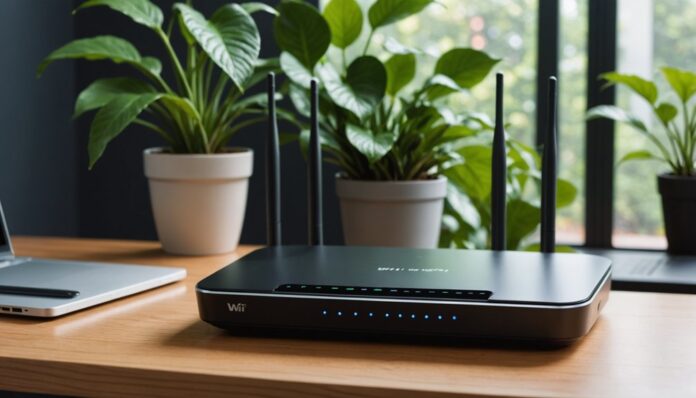Individuals experiencing Wi-Fi connection issues often assume that upgrading their plan is the only solution. However, this may not be necessary. Several strategies can be employed to enhance Wi-Fi without changing plans. By optimizing the router’s location, upgrading its antennas, and utilizing range extenders, users can improve their connection. Understanding these options is key to achieving faster speeds and wider coverage, potentially eliminating the need for a plan upgrade.
Highlights
- Move your router to a central, raised, and unobstructed location to maximize signal strength and reduce dead spots.
- Upgrade your router’s antennas to high-gain or directional options to elevate signal strength and coverage.
- Reduce interference from other devices by switching them off or changing the Wi-Fi channel to minimize overlapping with neighboring networks.
- Use a Wi-Fi range extender to rebroadcast signals to hard-to-reach areas and enhance coverage.
- Change your Wi-Fi channel to one with minimal interference using tools like Wi-Fi Analyzer to ensure stable connections and boost network performance.
Move Your Router to a Better Location
By placing the router in a strategic location, individuals can markedly improve their Wi-Fi coverage and overall network performance.
Effective router placement maximizes signal strength, reducing dead spots and connectivity issues. A central location, raised and unobstructed, allows the signal to radiate evenly throughout the space. This is particularly vital in homes or offices with multiple floors or numerous physical barriers.
Placing the router near the area where devices are most frequently used can also boost performance. It is essential to experiment with different locations to identify the best placement.
Individuals who prioritize router placement can experience significant improvements in their Wi-Fi network’s coverage, reliability, and overall performance. This simple adjustment can greatly enhance the online experience for all connected devices.
Upgrade Your Router’s Antennas
Optimizing router placement is just the first step in enhancing Wi-Fi performance. Upgrading the router’s antennas can greatly elevate signal strength and improve coverage.
Various antenna types are available, including omnidirectional, directional, and high-gain antennas. Omnidirectional antennas provide equal coverage in all directions, while directional antennas focus the signal in one direction. High-gain antennas amplify the signal, increasing its strength and range.
By choosing the right antenna type, users can enhance their Wi-Fi experience. Replacing the standard antennas with high-gain or directional antennas can improve signal strength and reduce dead zones.
This simple upgrade can make a noticeable difference in Wi-Fi performance, providing a stronger and more reliable connection for devices. Improved signal strength enables seamless connectivity, making it ideal for heavy internet users.
Reduce Interference From Other Devices
Minimizing interference from other devices is an essential step in enhancing Wi-Fi performance. Various electronic devices in the home or office can act as interference sources, disrupting Wi-Fi signals and reducing network efficiency.
These devices include cordless phones, microwaves, baby monitors, and neighboring Wi-Fi networks. To mitigate this issue, users can take several steps. They can switch off devices not in use or relocate them to minimize interference.
Changing the Wi-Fi channel on the router can also help avoid overlapping channels with neighboring networks. Additionally, replacing devices that use the 2.4 GHz frequency band with those that use the 5 GHz band can further reduce interference.
Use a Wi-Fi Range Extender
How far does a Wi-Fi signal actually travel? In reality, physical barriers such as walls, floors, and ceilings can notably limit its range.
A Wi-Fi range extender can help bridge this gap. By placing an extender in a strategic location, individuals can rebroadcast their Wi-Fi signal to hard-to-reach areas.
Wi-Fi placement is essential, as it should be positioned in an area with a strong signal to guarantee reliable coverage. Extender setup typically involves connecting to the device using a computer or mobile device and following manufacturer-specific instructions.
Ideal extender placement and setup can greatly improve Wi-Fi coverage and strength. Individuals can enjoy seamless connectivity throughout their space, without the need for an upgraded plan.
A well-placed Wi-Fi range extender can make a noticeable difference in overall Wi-Fi performance.
Change Your Wi-Fi Channel
What’s often overlooked when setting up a home network is the Wi-Fi channel. This can lead to channel congestion, resulting in slower internet speeds. Changing the Wi-Fi channel can greatly enhance the network’s performance.
Routers typically use a default channel, but nearby networks may be using the same channel, causing interference. Identify the best frequency by using tools like Wi-Fi Analyzer to scan available channels.
Select a channel with minimal interference to guarantee a stable connection. Switching to a less crowded channel reduces congestion and allows devices to communicate more efficiently.
Conclusion
Enhancing Wi-Fi without upgrading your plan is achievable through strategic adjustments. By relocating the router, upgrading antennas, reducing interference, utilizing a range extender, and switching Wi-Fi channels, users can notably improve their wireless experience. Implementing these simple yet effective tactics can improve signal strength, reduce dead zones, and elevate overall network performance, making the most of your existing plan. With these tips, users can enjoy a faster and more reliable connection.

